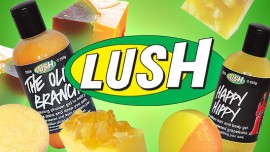
Israel's beloved chocolate marshmallow treat isn't just back in stores - restaurants and gelaterias are also giving it a gourmet makeover.
This year, once again, krembo season kicked off early. In August, the soft domes with cookie bottoms started making their way from assembly lines into freezers. At the end of September they reached stores, since which time they've been selling like, well, the proverbial hotcakes.
"Every year we start production a few days earlier," says Sharon Bar Oren, deputy CEO for marketing at Strauss Ice Cream, which produces about 35 of the 50 million krembos sold in Israel during the fall and winter.
So what is the secret behind the success of this simple confection known to every child? Maybe it's that this classic treat never changes at all.
The first machine to make krembos was brought to the Artik factory in Israel in 1963, and there the sweet was given its name, a portmanteau of mixed European (basically French ) and Hebrew origins meaning "cream inside." The idea was to produce an ice cream substitute "that doesn't chill the throat," as stated by the Whitman Company (which was eventually bought by Strauss ).
Over the years, attempts to refine the product all failed miserably. They tried to make a krembo in the shape of a pyramid, a krembo with a pink strawberry filling, and a krembo with colorful coating to replace the chocolate on the outside. All of these sold in a very limited capacity, until the public flattened them once and for all: It consumed only vanilla krembos coated in something called tzimcao, which contains way too little cocoa butter to be called chocolate. Though anyone really, really persistent can track down - but not always find - a mocha krembo.
In Europe they make a smaller, more compact krembo, coated in real chocolate, with meringue and gelatin inside. In Switzerland it is called a Mohrenkopf and in Germany a Mini-Dickmann.
In Israel the treats are not manufactured with gelatin, but rather with tablets of egg concentrate. Beaten hard with water and sugar, this becomes the sweet, white foam of the krembo, which is then poured onto a cookie wafer and covered in chocolate-flavored liquid. All of this is done at a cool temperature of 5 degrees Celsius or less, to avoid any damage to the pampered confection.
Going Danish
The craving for krembo has spread everywhere: Top restaurants are offering prestigious versions as dessert, and during this past month gelaterias have added them to ice cream.
Ran Ben Avraham, who studied confectionary in Denmark, makes a Danish version of the familiar krembo at Zisseleh, his gelateria in Tel Aviv.
"The Danes fill the krembo with an egg-white meringue, to which sugar has been added, and this is then mixed in a double boiler with hot water," he says. "A sticky mass, reminiscent of marshmallow, is created. They put this on a wafer and cover it with coconut, dolce de leche orange chocolate or white chocolate." Ben Avraham sells the bite-sized confection for NIS 7.
There are also elegant krembos, in which other ingredients are placed on the wafer. The idea to sell krembos at an ice cream shop also came from Denmark, where "they mash them into ice cream flavors," says Ben Avraham. "It's very tasty despite how it sounds."
Chef Eldad Shemtov, of the newly opened Shakuf restaurant in Jaffa, puts emphasis on unusual flavors and uses the krembo as a surprising finish to a meal - more of a "palate cleanser" than a dessert. Shemtov, who has worked at Herbert Samuel in Tel Aviv and interned at restaurants like Per Se in New York and Noma in Copenhagen, serves a bite-sized krembo based on a seasonal fruit or vegetable juice, whipped together with eggs and cream. The slightly sweetened cream and the wafer contain a few flecks of ground malt, adding a bitter flavor.
"The krembo is covered in a thin layer of chocolate and served on a sea stone. The fruit or vegetable ingredient changes daily," he explains. "This week, for example, we served krembos based on carrot and wild thyme."
Confectioner Liran Gruda of the Napoleon confectionary shop in Jaffa makes his krembo from whipped cream and milk. He bakes the wafer himself and the coating is made of Belgian chocolate.
"I love retro confections like krembo, bananit and 'hot ice cream' and I enjoy making them in a natural way, without powders," he says. "This year I plan to make krembos in banana and mocha flavors."
At the Jaffa restaurant Carmela Banahala, chef Daniel Zach has been making gourmet krembo for dessert for a decade now.
"Every time I want to take it off the menu, there's an outcry," he says. "This is our most veteran dessert." The dish was concocted by confectioner Barry Sayag, who has since left the restaurant, but the recipe remains unchanged.
"We make a thick mousse of whipped cream, passion fruit juice and white chocolate and we whip it until it's a strong and stable foam. Then we put the foam on a wafer that we bake ourselves, and cover it all with chocolate ganache," explains the chef. The krembo is served as part of a tasting platter of desserts, or alone - for addicts.
"The hardest thing is explaining it to tourists," complains Zach. "It takes a while to explain what a krembo is. To Israelis it's obvious."
http://www.haaretz.com/culture/food-wine/the-craving-for-krembo-1.322791
The Truth About Krembo – Israel’s Sweetest Obsession
Krembo is an Israeli sweet that is virtually unknown outside the small Middle Eastern country. Variations on the theme have appeared in a few European countries but they have never stirred the same amount of passion – and debate – as they have in Israel.
Since 1963, the Krembo is by far Israel’s favorite sweet. Forever identified with the coming of winter, it is too fragile to survive the blistering Israeli summer. Kids know that the appearance of the Krembo in the grocery store means that winter, rain and cold cannot be far behind.
With the arrival of Krembo season comes the national debate about it. We may discuss the peace process, we may fight endlessly about the government’s social-economic policy, but the real debate among Israelis is about the right way of eating a Krembo; namely, top-to-bottom or bottom-to-top? Every Israeli child has his or her favorite way of eating the small biscuit-based, chocolate-covered fluffy vanilla filled Krembo. There are those who will carefully eat the outside chocolate first, then the filling, leaving the biscuit for last. And there are those who start with the biscuit, plunging their teeth into the creamy filling only later. Whatever your favorite way of eating the Krembo, you will fight forever to defend your Krembo way of life – and never waver from it.








